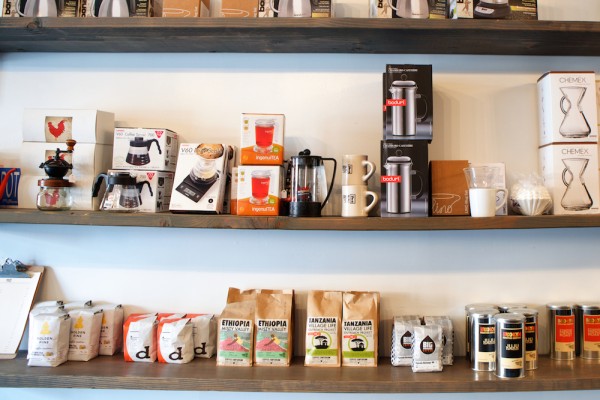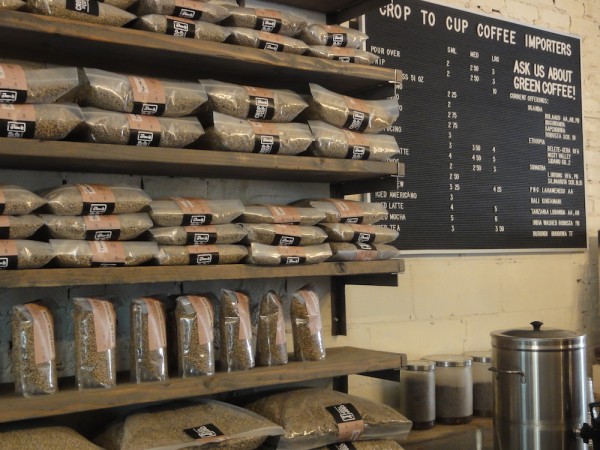There’s a relatively new coffee spot in Gowanus, Brooklyn, that has many of the trappings associated with today’s high-end retail shop, including grinders, brewers, lounge seating, bags of roasted coffee on the shelf, even sample roasters. But look closely and you realize the star of this shop is something not often seen by consumers: green coffee.
All those retail trappings are actually pieces in a green coffee showroom, a new concept from Brooklyn-based importer Crop to Cup, designed to attract home and commercial roasters who may be interested in at least two pounds of green coffee, as well as people who just want to pop in for a more traditional coffee shop experience.
In a sense, the showroom is the importer’s take on the roaster-turned-retailer model. Along with bagged coffee made available by a rotating lineup Crop to Cup’s roaster partners, the showroom allows for interactive roasting, brewing and sampling of available green coffee, with ample opportunities to engage customers in virtually any aspect of the farm-to-cup process.
We asked Crop to Cup Co-Founder and President Taylor Mork to help us understand the thinking behind a consumer-facing green coffee place, and what kind of experience he hopes the showroom will create for such a diversity of customers.
How big is the showroom space?
It is about 900 square feet. It is in a traditional retail location, not a warehouse location. The majority of our inventory is still kept in big coffee warehouses like Continental in New Jersey, so it is in a space more like a café than a big coffee warehouse with pallets stacked high.
What went into the interior design and the concept of bringing green coffee to the forefront?
When you walk in, you reach the end of our long coffee bar made of raw steel. “Raw as beautiful” is evident throughout the space — from the unfinished cold-rolled steel that makes up the bar, and the counter and shelf brackets, to the very lightly finished wood, to the raw grain pattern of the plywood floor, to of course the green/raw coffee throughout. The essence is raw, not rustic. We wanted to show that raw can be shiny and new, not old and worn. The raw contrasts nicely with a La Marzocco GB5, sample roaster and all the other nice coffee tools one might see around a coffee store.
What is the purpose of selling roasted and by-the-cup brewed coffee drinks from your roaster partners?
This is a showroom where customers can experience the coffees we import, as interpreted by the roasters to whom we sell across the country. The roaster line up changes about once per month. For example the current lineup is Café Demitasse (Calif.), Buon Giorno (Texas), Brooklyn Roasting Co. (New York), Big Shoulders (Ill.), and Golden Pine (Colo.).
As an importer, you’re kind of heightening the presentation of green coffee here? How did this concept evolve?
Green coffee importing and selling has always been hidden behind the drab façade of excel sheets on importers’ websites, in FedExed sample envelopes and in big commercial warehouses that only the truck drivers get to see. Or, for home roasters, the community is stuck either on a website selling greens or in an online message board where roasters discuss the newest equipment and the geekiest mods.
Our goal with the Importers Showroom was to bring green coffee to eye level — to a level where commercial buyers can come interact with a person to talk import planning and to cup coffees. The same for home roasters, just on a smaller scale. Home roasters appreciate the ability to buy the same coffees in 2-pound volumes that big commercial roasters buy in 2-ton volumes, and receive the same level of customer service and support. And for the non-roaster consumer — we’ll call them drinkers — the Showroom brings coffee to a level where the supply chain becomes much more clear and digestible, so that they don’t have to just read about it on the back of a coffee bag, but in fact see it and join it on the cupping table where we are roasting and cupping samples of prospective coffees, newly landed coffees, and warehoused coffees nearly every day.
How does roasting fit in, either as an educational tool or as a practical tool?
Being a showroom of the supply chain, we of course couldn’t just leave the roasting part out, so we also have a way for visitors to learn about the roasting process via the home roasters we sell and train on. We also offer sample roasting services for roasters that don’t have their own sample roasting equipment and request us to send them roasted samples over green, or who want to come in and use our sample roaster as they evaluate options.
First and foremost, the showroom showcases coffee origins – every other item or process in the space is just one of many tools a visitor can use along the path to gaining a deeper understanding of the coffee origins — to add more dynamism to the respect a consumer may have for the coffee’s farmer. To do this, a visitor can explore the difference of naturals vs washed in flat bottom pourover vs cone pourover, or cup multiple roast curves of the same coffee, or taste an espresso that uses one or more of our origins. Take a coffee, any coffee, and see what’s possible. And the next day, chose a different coffee or a different route. That’s the exploratory dive we want our customers to take.
Outside of a unifying explorative curiosity, you seem to be playing to a pretty diverse crowd. Since opening, has your audience lined up with your pre-opening expectations?
I’ll touch on the packaged roasted beans and the pourover options first — i.e.. the “café customer” portion. Customers get excited about new roasters that they have never heard of. For coffee geeks, it’s fun to come to a place and taste coffees from specialty micro-roasters from Fort Collins, Colo., Fort Worth, Texas or Torrington, Conn. There’s so much more to specialty coffee than the same old “mega specialty” roasters from Brooklyn, Chicago and Portland you see on every block in NYC — you know who I’m talking about. I don’t knock them for their success and their quality is amazing — and our model is never to push customers towards any particular roasting company or roasting style — but I can sense that customers are eager for more diversity in that landscape.
Now to touch on our main markets: home roasters and commercial roasters. With so few physical stores to ever offer them much, there’s a reason that so much of home roasting buying and chatter is done online. Getting home roasters into the store is a long process. It will take years for home roasters in the New York area to realize there is a physical store they can visit and use as a launching pad to explore new origins. They do come, just not yet in droves. But the ones who do come are so passionate about quality and so fun to talk with. We spend anywhere from 10 minutes to two hours with people buying as little as two pounds, just because there is so much to talk about.
For commercial roasters, where we have seen a very strong response is the New York-region small startup roaster crowd — it seems like a new player is entering the roasted wholesale game in New York every week. Small and new roasters really value the ability to come taste coffees with us and use our space as a place to educate themselves as they get started and grow. They also value the ability to buy coffee in split bags — for example, picking up a half bag on the way to roasting over at Pulley Collective, which is not far from us. By not being tied to full bag volumes from other importers or to the high shipping cost of shipping small bags from online sellers in California, they can free up cash flow to invest in other areas of the business, or add more coffees to their roasting lists.All that said, the concept of a green coffee store is new, for both commercial buyers and consumers. We still have a long way to go to get a viable volume of visitors in the door.
Nick Brown
Nick Brown is the editor of Daily Coffee News by Roast Magazine.
Comment
1 Comment
Comments are closed.












That is really interesting information thank you for posting it.